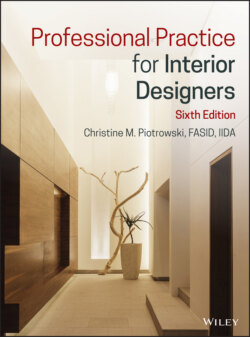Читать книгу Professional Practice for Interior Designers - Christine M. Piotrowski - Страница 24
Financial Resources
ОглавлениеMarketing brings in clients with projects. Those projects bring in the funds to pay salaries and operate the business. Our industry and profession have suffered through recessions as well as exceptional economic times. But the financial resources needed to operate the practice are never easy to obtain and retain. When your boss is concerned about someone in the office using the telephone or Internet for personal use, she is probably remembering that those personal calls cost the company—not the user—money.
A firm makes money by charging design fees for services and perhaps by selling merchandise to clients. Design services have a cost to the company, as well as representing revenue. The biggest cost to the firm for providing design services is the salary of the designer. As you will read in Chapter 29, salary is not the only part of the employee cost of providing design services.
There are other costs involved in those services. The company has to pay utility bills, buy supplies like pens and ink for the printer, and pay monthly Web fees. These operating expenses are deducted from the revenue that is obtained from clients. Only after the expenses are paid does the firm make a potential profit. And when there is no profit, there are no funds for the owner to provide benefits to employees.
You might not think it's important to understand accounting, but it is. Chapter 28 on basic accounting and money management will not teach you how to be an accountant or how to keep the financial records, but it will help you understand the important point that revenue and profit are not the same thing. Just because the company has sold a sofa or charged a design fee does not mean it has made a profit and can now give you a raise.
Profit only results after all the expenses of the company are subtracted from revenue. So, when it costs your boss more to operate the company than the amount of revenue the company brings in, a loss occurs. Too many months of operating at a loss means the owner might have to let you go and even close the doors.
As a final note, the business of interior design, which is the professional practice of interior design, goes way beyond just design. It is important for the student, the emerging professional, and the experienced interior designer to understand ethics, legal issues, contract creation, and appropriate ways to be compensated for work. It is also critical to be a good project manager, as any project (regardless of size) has many components to be controlled. It is also important for anyone in the interior design profession to understand basic accounting, marketing strategies, and how to organize a practice, operate that business, and hire and manage employees. All of these topics and more are presented in this textbook.
The “real world” of interior design is at times glamorous. Yet, it is also many hours of paperwork to create specifications, prepare drawings, resolve problems with vendors, track missing furniture, and more problems that you probably don't want to read about right now! Mostly, it is an opportunity to create places for people to come home and be safe and comfortable, to encourage recovery from illness, to enjoy a special event or vacation, and so on. It is a great way to work and make a living. Very few interior designers who have worked for several years would say differently in good times—or bad!
